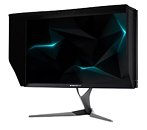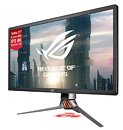Tuesday, April 10th 2018
4K Ultra HD Monitors with 144 Hz Refresh-rate and G-SYNC HDR Start Being Available
As we reported in March, the first 4K monitors with 144 Hz refresh-rate began showing up in stores. This summer, PC gamers and enthusiasts up for a monitor upgrade, are in for a treat. An increasing number of companies are preparing to launch monitors with not just 4K Ultra HD resolution (3840 x 2160 pixels), but also staggering 144 Hz refresh-rates, and support for adaptive sync technologies, such as AMD FreeSync and NVIDIA G-Sync. To push 4K at 144 Hz, you'll need your graphics card to feature DisplayPort 1.4 (or above) connectivity, as DisplayPort 1.2, or even the newer HDMI 2.0, lack the required bandwidth.
Among the first blazing fast 4K UHD + 144 Hz monitors, are the 2018 Acer Predator X27 (UM.HX0EE.009) first unveiled in 2017, and soon to be joined by the ASUS ROG Swift PG27UQ. Both monitors feature 4K Ultra HD resolution, 144 Hz refresh-rate, IPS quantum-dot panels, and support for the new NVIDIA G-SYNC HDR standard. The monitors take input from DisplayPort 1.4 and HDMI 2.0, although you will need DisplayPort 1.4 to get 4K @ 144 Hz to work correctly. The IPS quantum-dot panels feature DCI-P3 color-standards, 99% Adobe RGB coverage, and 10 bpc (1.07 billion-color) palette, in addition to 384 LED elements backlighting the panel. The ROG Swift PG27UQ starts at 2,445€ and the Predator X27 at 18,475 DKK Sounds good? Get ready to foot upwards of USD $3,000 for either of them, to go with your $3,000 TITAN V, for a 3,000-inch e-p.
Among the first blazing fast 4K UHD + 144 Hz monitors, are the 2018 Acer Predator X27 (UM.HX0EE.009) first unveiled in 2017, and soon to be joined by the ASUS ROG Swift PG27UQ. Both monitors feature 4K Ultra HD resolution, 144 Hz refresh-rate, IPS quantum-dot panels, and support for the new NVIDIA G-SYNC HDR standard. The monitors take input from DisplayPort 1.4 and HDMI 2.0, although you will need DisplayPort 1.4 to get 4K @ 144 Hz to work correctly. The IPS quantum-dot panels feature DCI-P3 color-standards, 99% Adobe RGB coverage, and 10 bpc (1.07 billion-color) palette, in addition to 384 LED elements backlighting the panel. The ROG Swift PG27UQ starts at 2,445€ and the Predator X27 at 18,475 DKK Sounds good? Get ready to foot upwards of USD $3,000 for either of them, to go with your $3,000 TITAN V, for a 3,000-inch e-p.


43 Comments on 4K Ultra HD Monitors with 144 Hz Refresh-rate and G-SYNC HDR Start Being Available
I thought i was crazy for giving the Alienware AW3418DW serious consideration. If it wasn’t curved i probably would have bought it.
It looks like I am going to upgrade to 1440p @144Hz after all. It will take 2+ more years before that early adopter tax comes down.
No reason for everyone to be up in cahoots over the pricing. The amount of manufacturers that make monitors is decent, at least it's not like a NVidia vs AMD deal where theres only 2 of em to make monitors.
Competition will come soon enough, prices will go down, we will all rejoice.
For example, a monitor with a 60 Hz refresh rate has a 16.6ms time gap between each screen refresh while a monitor with a 144 Hz refresh rate only has a 6.9ms gap between each screen refresh. This means that a 144 Hz monitor has an additional 9.7ms advantage. A 144 Hz monitor has enough extra time there for even slow pixels to refresh and change color before the 60 Hz monitor even has a chance to request the pixel to change color.
TLDR; faster refresh rates allow the monitor to get the pixel color change (response time) ball rolling, thus giving high refresh rate monitors an advantage regardless of pixel response times.
I think I'm gonna stick with 2.5K for a decade or so. The improvements in other aspects such as HDR and quantum dot are welcome though.
NVIDIA has been stating for at least 2 years that 4K was the future of gaming, and now that the chance is getting close, these prices won't hold. The initial price is just like any new item, example, GPU's. When new, are expensive, to recoup some R&D cash. After awhile, a 3rd party corporation comes in with essentially the same monitor, only throws in a TN panel rather than IPS & shash 50% off the price, then the war is on, pricing will dip.
It's a crying shame when 4K monitors (at 60Hz) are typically selling for less than 2K monitors. I mean, 4K is 4x the pixels of 1080p, while 2K is only 1080p x2. One would think that the 4K model would be more expensive, yet it's backwards, paying more for less pixels, some of these 4K monitors (like mine) has a 1ms refresh rate, the best one can get.:)
If these newer 4K monitors for the price runs slower than 1ms, then for sure it's not worth having. I'd imaging these are going to be fast. Not to worry, NVIDIA will have the GPU's to push these monitors, some with dual 1080 Ti's are likely set to go, any 10 series card is DP 1.4 capable. It's about time that DP 1.4 monitors hit the market, it's has been a standard for over 2 years w/out the hardware to take advantage of that speed. Which is something else to consider. Most of with 1070/1080 (to include Ti for both) has no idea of how fast our cards can run at DP 1.4, because wh haven't had any monitor to match that speed, there may had been a DP 1.3, I believe primarily for medical imaging usage. Therefore, our cards may be faster than we think, especially in a SLI configuration.:D
Not to worry, time is the answer, these OEM's wants to sell these to the wealthy & upper middle class who has the cash first, then once there's more competition (again, one may have a TN panel), pricing will drop. Think about it, just 5 years ago, how many of us had 4K (or 2K) monitors? Now both are everywhere. often on promo, my Samsung 4K could had been $224.99 at Costco on Black Friday 2016, but I didn't think to look, felt that 4K wasn't in my budget. I eventually got the same monitor for $299.99 (Samsung 28" U28E501D). One of which Samsung placed a similar model number on for most every big brand retailer, and sold the one on their site (the core version) for $100 more. It's a 2015 model, lacking USB ports, but it gives me 4x the real estate (pixel count) over the 24" ASUS sitting in the other corner that was $30 more in 2014. What more could I want for $300?:)
Now, these will never drop that low, yet I'd say that $1,000 won't be far off the mark come 12-18 months, there's also 5K monitors on the market. Dell having one, they may want to make it push the same limits, unless these are for professional usage only.
Things will be OK, remember that many of us has GPU's that'll do 8K (including the GTX 1060) & that'll be the next big release afterwards (at 60Hz for awhile) for the OEM's, once they can profit from 144Hz technology for 4K. No need to hit the panic button over an initial release, I'd bet that some who has didn't have the 1st issue with dropping $1,000+ for a CPU (Intel or AMD Threadripper).:)
Cat
But that's the cost when you buy one piece.
HDR, I'm not even sure G-Sync has anything to do with that. G-Sync only times when a refresh happens, it shouldn't care what that screen is made up of. I also haven't heard of a new HDR module being released specifically for HDR.
This panels over 3 years old and has no problem (5.5 ms avg / 6.9 worse case ... which is < 7.0)
www.tftcentral.co.uk/reviews/acer_xb270hu.htm#response_times
Not to mention a 3 ms lag time
and the 2+ year old panel in the XB271 HU is 15% faster.
Those G-Sync hardware modules were initially released for the Asus 144 hz panel released b4 G-Sync was really ready. But, the thing is, those monitors were also capable of motion blue reduction voia toastystrobelight utility. That's the big deal between G-Sync and Freesync ... both have their greatest impact between 40 - 70 fps (30-70 for G-sync) ... but above that, G-Sync monitors provide the option to switch to ULMB which is what gamers generally prefer once ya get up above 70-75 fps. At today's cards can consistently deliver that performance at 1440p. At 4k ... I don't know what next generation will bring but it is likely to be close.